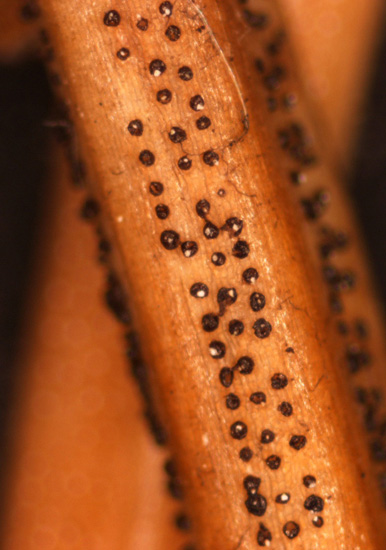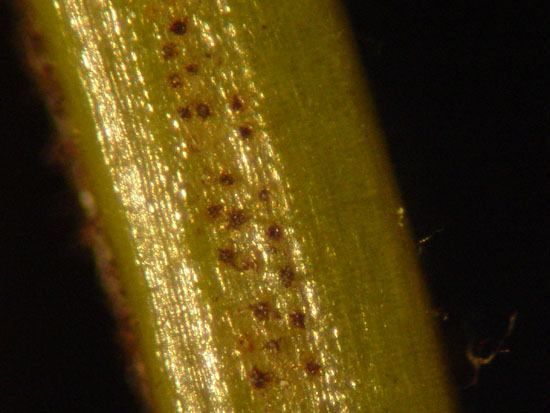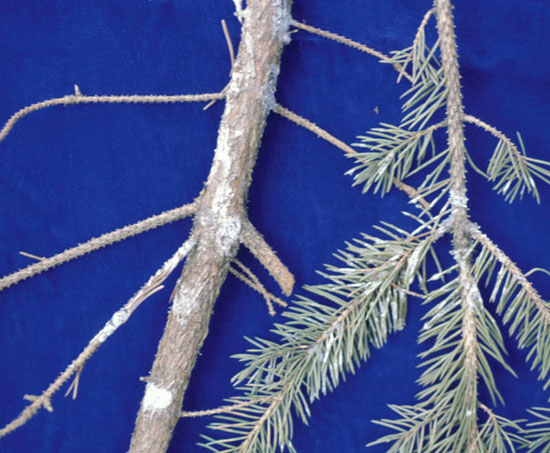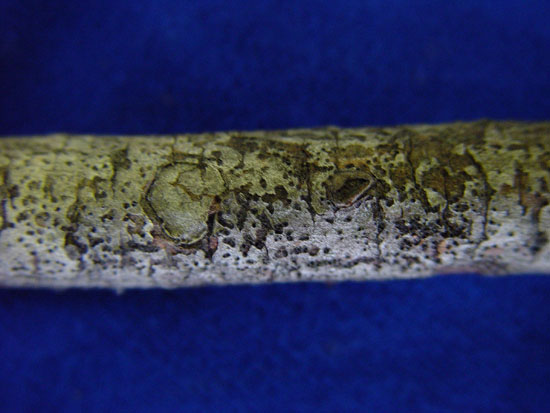Issue 2, May 2, 2011
SOS: Help My Spruce is Dying!
If you needed me a week ago, I was at the Plant Clinic buried under a large sample load of evergreens. Most of the samples were taken from Spruce trees. The Plant Clinic received many calls about Spruce tree problems, often times, with the same description of symptoms. I suggested that a sample be sent to the Plant Clinic, for an accurate diagnosis. I diagnosed the spruce samples with the following diseases:
Rhizosphaera
The most common disease, especially on Colorado blue spruce, is Rhizosphaera needle cast. The symptoms of this disease are purpling of needles, needle drop, and infection that can start at the bottom of the tree and proceed upward. This disease should be accurately diagnosed, because it can be easily confused with Stigmina species fungus. There are chemical controls that can help protect new growth from infection if caught early. At least 2 years of fungicide applications are required. After this time period, I would reevaluate the spruce for disease. Rhizosphaera needle cast is not known to kill the tree, but can cause it to look very unsightly. The most important thing to do is to remove and destroy all diseased plant material near your spruce trees! Remember, if you have a problem with Rhizosphaera needle cast, I would consider planting Norway spruce, because they are known to have some resistance to this disease.

Stigmina
I have seen a lot of Stigmina species fungus the last several years on evergreen needles. Its symptoms and fungal fruiting structures are very similar to Rhizosphaera needle cast. Unfortunately, there has not been a lot of research of this fungus, so not a lot is known. But, it is suspected to be an opportunistic fungus, which means it will infect stressed plants. If your spruce is diagnosed with this fungus on its foliage, you should try and relieve any stress to the tree (if possible). Reports have indicated limited success with fungicide control of the Stigmina fungus.

Cytospora
Another nasty disease that we often suspect on spruce is Cytospora canker, especially if we see oozing sap (white substance) coming from areas of the base or limbs of the tree. These cankered areas will girdle the tree at the base and cause branch death. When stems are girdled, the newest needles usually die first. This fungal pathogen invades stressed trees and cannot be eradicated, once infection has occurred. Management for this disease starts with pruning and destruction of infected branches. Then try to alleviate any tree stress and improve tree vitality. There are no effective chemical controls for Cytospora Canker.

Sphaeropsis Blight/ (Diplodia) Tip Blight
A few of the spruce samples that I looked at were infected with Sphaeropsis pungens, which causes a fungal disease called Diplodia Tip Blight (aka Sphaeropsis blight). This disease can infect evergreen buds and needles; however I only found this pathogen within cankers on the stems and branches on the samples that were recently submitted to the Plant Clinic. The canker phase of Sphaeropsis blight can girdle branches and cause all growth beyond that point to die, thus causing the evergreen to look very, unsightly! There are fungicides listed for pines infected with Sphaeropsis tip blight, but not Spruce. In the case of any cankered tree, I suspect the tree is stressed. You should prune and destroy all infected plant material and improve tree vitality.

The wet, spring weather the last several years has been very favorable for the spread of diseases like Rhizosphaera needle blight. In addition, homeowners may not take the time to clean up plant debris, which harbors disease.
What do all these spruce diseases have in common? They are all known to be fungal pathogens that infect stressed trees. This means there may be a series of problems going on with the tree. You need to take a look at the site and try to alleviate any stress, if possible. Remember to prune trees during dry conditions! It also may be helpful to fertilize the spruce in the fall or early spring to improve tree vitality.
What can cause a spruce to be stressed? First of all, weather could be a factor. Many trees have been stressed thanks to the extremely wet weather. Some areas of Illinois had a very dry summer last year. Spruces do not grow well in hot, dry climates, thanks to their shallow root system. This is why we often suggest watering during drought stress and mulching over the root system of the tree.
Other factors that may be stressing the tree could be incorrect planting, injury to the base, root disturbance, compaction, chemical use near root zone, incorrect soil pH ... just to name a few. Of course, none of these issues can be detected in our lab.
Last, but not least, don't forget about insect stress. I found signs of Spruce spider mites in addition to disease on many of the spruce samples. Also, a few samples had bagworms and signs of Adelgid. (Stephanie Porter)
Author:
Stephanie Porter